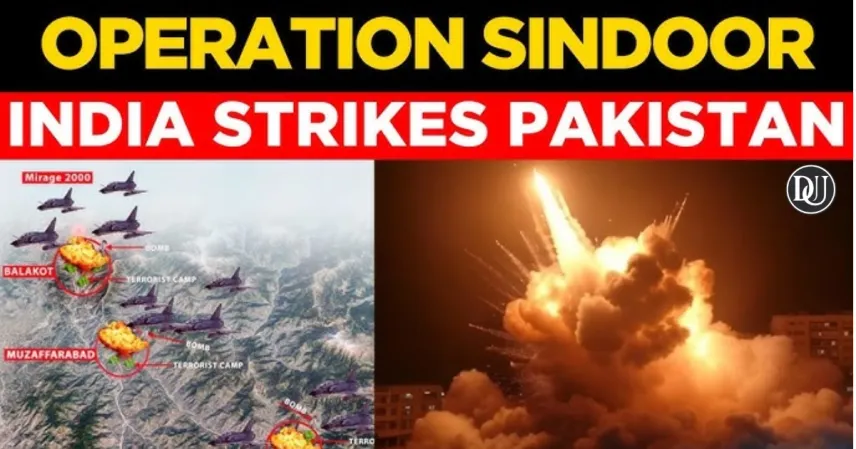In a decisive retaliation to the deadly terrorist attack in Pahalgam, Jammu and Kashmir, India carried out a series of precision air strikes deep inside Pakistan and Pakistan-administered Kashmir under a high-risk military operation codenamed "Operation Sindoor". The strikes were conducted late on the night of May 6, 2025, and mark one of the most sophisticated Indian aerial offensives since the Balakot strikes of 2019.
✈️ Execution of the Air Strike: Precision Warfare at Work
![]()
The operation was launched at around 2:30 AM IST, when Indian Air Force (IAF) fighter jets—primarily Rafale aircraft—took off from multiple airbases, including Ambala and Gwalior. The jets did not enter Pakistani airspace but used stand-off missiles to launch strikes from Indian-controlled airspace, showcasing India's maturing aerial capabilities.
Key features of the operation:
-
Aircraft used: Rafale jets and Su-30MKIs (as backup)
-
Missiles deployed:
-
SCALP cruise missiles with a 500+ km range
-
Hammer precision-guided bombs for low-collateral damage
-
-
Flight path: Jets crossed Jammu and Kashmir airspace, stayed out of Pakistan’s radar, and fired stand-off missiles.
-
Time of impact: Between 2:45 AM and 3:10 AM
The strike was reportedly aided by real-time satellite surveillance and AWACS (Airborne Warning and Control Systems) to ensure precise targeting and avoid civilian zones.
🎯 What Was Hit: Targets of the Air Strike
According to top-level military sources, India targeted nine key locations identified as terror hubs. These locations were under surveillance for over a month, and satellite images confirmed active terror activity.
The primary strike zones:
-
Muzaffarabad (PoK): Two terror training camps used by Lashkar-e-Taiba.
-
Kotli (PoK): A weapons and explosives storage facility.
-
Bahawalpur (Pakistan): Headquarters of Jaish-e-Mohammed, housing senior operatives.
-
Muridke (Punjab, Pakistan): A madrassa and mosque complex associated with Hafiz Saeed—this was one of the most high-profile hits of the operation.
-
Bhimber (PoK): A logistical base used for infiltration operations across the LoC.
The choice of targets suggests a clear intention to destroy infrastructure used to support cross-border terrorism, not Pakistani military installations, to avoid a wider war.
📸 First Visual Proof: Damage to Hafiz Saeed’s Network
जब तक तोड़ेंगे नहीं, तब तक छोड़ेंगे नहीं।
— Brajesh Misra (@brajeshlive) May 6, 2025
इतने बम मारे कि पाकिस्तान धुआं धुआं हो गया।
भारत माता के वीर जवानों ने पाकिस्तान पर चढ़ाई कर दी है। #OperationSindoor #भारतीयआर्मी pic.twitter.com/T96jga8hKo
India Today released exclusive visual evidence of the strikes showing:
-
A heavily damaged mosque and madrassa complex in Muridke.
-
Satellite imagery confirmed a direct hit on the compound, with collapsed rooftops and cratered terrain.
-
Burnt vehicles and destroyed warehouses, believed to store arms and explosives.
Defense analysts noted that this footage corroborates India’s claim of high-precision targeting, further supported by zero IAF casualties reported.
🇵🇰 Pakistan's Reaction: “Act of War”
Within hours of the air strike, Pakistan’s Prime Minister Shehbaz Sharif addressed the nation, condemning the strike as an “unprovoked act of war.” He claimed:
-
Five sites in Pakistani territory were hit.
-
Eight civilians, including a child, were killed.
-
35 people were injured.
-
Five Indian aircraft were shot down—though no visual or independent confirmation supports this claim.
Pakistan has since:
-
Shut down its airspace for civilian aircraft.
-
Mobilized troops along the Line of Control (LoC).
-
Initiated retaliatory shelling, which killed three Indian civilians in Kupwara district.
Sharif warned, “Pakistan will respond at a time and place of our choosing.”
🌐 International Community Calls for Restraint
The air strike triggered swift global reactions:
-
United Nations Secretary-General António Guterres urged both countries to "exercise utmost restraint" and avoid escalation.
-
The United States and France, while condemning terrorism, urged de-escalation and offered to mediate peace talks.
-
Russia and China called for respect of territorial integrity but refrained from blaming either side.
Many experts worry this could spiral into another prolonged military standoff like the post-Pulwama 2019 conflict, but with even higher stakes now due to broader targeting and deeper territorial penetration.
🧠 Strategic Implications: India’s Evolving Doctrine
Operation Sindoor is a bold signal that India’s strategic patience is wearing thin. The use of stand-off weapons, real-time intel coordination, and non-intrusive airspace tactics suggests a shift in India’s military doctrine—prioritizing:
-
Precision over escalation
-
Surgical retaliation over full-scale war
-
Avoiding civilian casualties while eliminating terror nodes
Defense analysts believe India has embraced a “deterrence through disruption” model, meaning it will act swiftly whenever red lines—like civilian casualties—are crossed.
🔍 Summary
| Aspect | Details |
|---|---|
| Operation Name | Operation Sindoor |
| Date of Strike | May 6, 2025 |
| Time | ~2:30 AM to 3:10 AM IST |
| Targets | 9 terror camps in PoK and Pakistan |
| Key Targets | Hafiz Saeed-linked mosque, LeT/JeM HQs |
| Weapons Used | SCALP missiles, Hammer bombs |
| Civilian Casualties | 8 in Pakistan (as per Pakistan) |
| Indian Losses | None confirmed |
| Pakistan's Response | LoC shelling, airspace closure |
| International Stance | Urged de-escalation |
📝 Final Word
Operation Sindoor could redefine how India tackles terrorism emanating from across the border. With advanced aerial capabilities, improved intel networks, and political resolve, the air strike strategy might become a cornerstone of India’s future counter-terror operations.
Whether this will lead to de-escalation or another cycle of violence remains uncertain—but the message is clear: India will hit back hard and smart.










